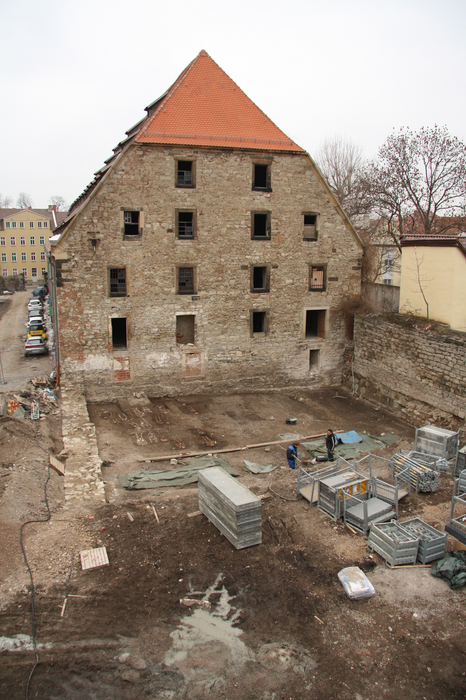Extracting ancient DNA from teeth, an international group of scientists peered into the lives of a once-thriving medieval Ashkenazi Jewish community in Erfurt, Germany. The findings, presented on November 30 in the journal Cell, show that the Erfurt Jewish community was more genetically diverse than modern day Ashkenazi Jews.

Credit: Waldman et al./Cell
Extracting ancient DNA from teeth, an international group of scientists peered into the lives of a once-thriving medieval Ashkenazi Jewish community in Erfurt, Germany. The findings, presented on November 30 in the journal Cell, show that the Erfurt Jewish community was more genetically diverse than modern day Ashkenazi Jews.
“Today, if you compare Ashkenazi Jews from the United States and Israel, they’re very similar genetically, almost like the same population regardless of where they live,” says geneticist and co-corresponding author Shai Carmi (@ShaiCarmi) of the Hebrew University of Jerusalem. But unlike today’s genetic uniformity, it turns out that the community was more diverse 600 years ago.
Digging into the ancient DNA of 33 Ashkenazi Jews from medieval Erfurt, the team discovered that the community can be categorized into what seems like two groups. One relates more to individuals from Middle Eastern populations and the other to European populations, possibly including migrants to Erfurt from the east. The findings suggest that there were at least two genetically distinct groups in medieval Erfurt. However, that variation in ancestral origins no longer exists in modern Ashkenazi Jews.
“Our goal was to fill the gaps in our understanding of Ashkenazi Jewish early history through ancient DNA data,” says Carmi. While ancient DNA data are a powerful tool to infer historical demographics, ancient Jewish DNA data are hard to come by, as Jewish law prohibits the disturbance of the dead in most circumstances. With the approval of the local Jewish community in Germany, the research team collected detached teeth from remains found in a 14th century Jewish cemetery in Erfurt that underwent a rescue excavation.
The researchers also discovered that the founder event, which makes all Ashkenazi Jews today descendants of a small population, happened before the 14th century. For example, teasing through mitochondrial DNA, the genetic materials we inherit from our mothers, they discovered that a third of the sampled Erfurt individuals share one specific sequence. The findings indicate that the early Ashkenazi Jewish population was so small that a third of Erfurt individuals descended from a single woman through their maternal lines.
At least eight of the Erfurt individuals also carried disease-causing genetic mutations common in modern-day Ashkenazi Jews but rare in other populations—a hallmark of the Ashkenazi Jewish founder event.
“Jews in Europe were a religious minority that was socially segregated, and they experienced periodic persecution,” says geneticist and co-corresponding author David Reich of Harvard University. Although antisemitic violence virtually wiped out Erfurt’s Jewish community in 1349, Jews returned five years later and grew into one of the largest in Germany. “Our work gives us direct insight into the structure of this community.”
The team believes the current study helps to establish an ethical basis for studies of ancient Jewish DNA. Many questions remain unanswered, such as how medieval Ashkenazi Jewish communities became genetically differentiated, how early Ashkenazi Jews related to Sephardi Jews, and how modern Jews relate to ones from ancient Judea.
“This work also provides a template for how a co-analysis of modern and ancient DNA data can shed light on the past,” says Reich. “Studies like this hold great promise not only for understanding Jewish history but also that of any population.”
###
The study was supported by the Israel Science Foundation grant, the United States–Israel Binational Science Foundation, the National Science Foundation, the National Institutes of Health, the Allen Discovery Center, the Paul G. Allen Family Foundation, the John Templeton Foundation, the Howard Hughes Medical Institute, and a private gift. Author declarations of interest are listed in the paper.
Cell, Waldman et al.: “Genome-wide data from medieval German Jews show that the Ashkenazi founder event pre-dated the 14th century.” https://www.cell.com/cell/fulltext/S0092-8674(22)01378-2
Cell (@CellCellPress), the flagship journal of Cell Press, is a bimonthly journal that publishes findings of unusual significance in any area of experimental biology, including but not limited to cell biology, molecular biology, neuroscience, immunology, virology and microbiology, cancer, human genetics, systems biology, signaling, and disease mechanisms and therapeutics. Visit http://www.cell.com/cell. To receive Cell Press media alerts, contact [email protected].
Journal
Cell
DOI
10.1016/j.cell.2022.11.002
Method of Research
Observational study
Subject of Research
People
Article Title
Genome-wide data from medieval German Jews show that the Ashkenazi founder event pre-dated the 14th century
Article Publication Date
30-Nov-2022
COI Statement
Author declarations of interest are listed in the paper.




